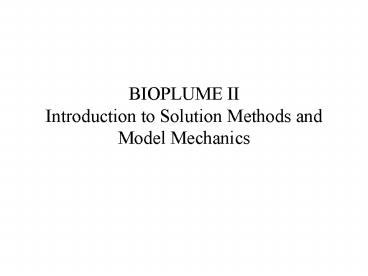BIOPLUME II Introduction to Solution Methods and Model Mechanics - PowerPoint PPT Presentation
Title:
BIOPLUME II Introduction to Solution Methods and Model Mechanics
Description:
First order decay. Instantaneous Biodegradation. Particle Movement. Limitations/Assumptions ... RADIOACTIVE DECAY. THALF - Half life of solute ... – PowerPoint PPT presentation
Number of Views:75
Avg rating:3.0/5.0
Title: BIOPLUME II Introduction to Solution Methods and Model Mechanics
1
BIOPLUME IIIntroduction to Solution Methods and
Model Mechanics
2
What does it do?
- Two dimensional finite difference model for
simulating natural attenuation due to - advection
- dispersion
- sorption
- biodegradation
3
How Does BPIII Solve Equations?
- Contaminant transport solved using the Method of
Characteristics - Particles travel along Characteristic lines
determined by flow solution. - Particles carry mass
- Advection solved via particle movement
- Dispersion solved explicitly
- Reaction solved explicitly
- First order decay
- Instantaneous Biodegradation
4
Particle Movement
5
Limitations/Assumptions
- Darcys Law is valid
- Porosity and hydraulic conductivity constant in
time, porosity constant in space - Fluid density, viscosity and temperature have no
effect on flow velocity - Reactions do not affect fluid or aquifer
properties - Ionic and molecular diffusion negligible
- Vertical variations in head/concentration
negligible - Homogeneous, isotropic longitudinal and
transverse dispersivity
6
Limitations of Biodegradation
- No selective or competitive biodegradation of
hydrocarbons (lumped hydrocarbons) - Conceptual model of biodegradation is a
simplification of the complex biologically
mediated redox reactions that occur in the
subsurface
7
BIOPLUME II Flowchart
8
HOW TO SET UP A MODEL
- 1. Data Collection Analysis
- 2. Modeling Scale
- 3. Discretization
- 4. Boundary Conditions
- 5. Parameter Estimation
- 6. Calibration
- 7. Sensitivity Analysis
- 8. Error Estimation
- 9. Prediction
9
SOURCE DATA
- Mass of contaminant
- Q, C0
- Discrete vs. Continuous
- Nature of contaminant
- Chemical stability
- Biological stability
- Adsorption
10
PARAMETER ESTIMATION
- 1. Porosity
- 2. Dispersivity
- 3. Storage coefficients
- 4. Hydraulic conductivity
- 5. Thickness of unit
- 6. Recharge rates
11
REGIONAL SCALE - QUANTITATIVE
- Aquifer characteristics
- Background gradients
- Geology
- Recharge sources
12
LOCAL SCALE - WATER QUALITY
- Site history
- Site characterization
- Source definition
- Nature of contamination
- Plume delineation
13
(No Transcript)
14
MOC TIMING PARAMETERS
- Total Simulation Time
- 1st pumping period
2nd - NPMP 2
- For Each Pumping Period
- PINT pumping period in yrs
- NTIM of time steps in pumping period
15
MOC BOUNDARY CONDITIONS
- Two types
- Constant Head
- Water Table constant
- Constant Flux
- Flow rate Q
- Concentration C0
16
MOC BOUNDARY CONDITIONSSpecifications of NCODES
- For Each Code in NOEID map
- LEAKANCE (s-1)
- vertical hyd. conduct. / thickness
- CONCENTRATION OF CONTAMINANT
- RECHARGE RATE (ft/s)
- NOTE
- For constant head cells set LEAKANCE to 1.0
17
MOC SOURCE DEFINITION
- Injection well
- Flow rate - Q
- Concentration - C0
- Constant Head Cell
- CC0
- Recharge Cell
- Flow rate - Q
- Concentration - C0
18
PHYSICAL AQUIFER CHARACTERISTICS
- 1. Transmissivity (ft2/s) VPRM
- 2. Thickness (ft) THCK
- 3. Dispersivity (ft)
- Longitudinal BETA
- Ratio DLTRAT Txx/Tyy
- 4. Porosity POROS
- 5. Storativity S
- NOTE
- For transient problems
- TIMX increment multiplier
- TINIT size of initial time step
19
MOC REACTION PARAMETERS
- NREACT
- Flag to instruct MOC to expect reaction data
- 0 - no reactions
- 1 - reactions taking place
- expect card 4 free format
- Two types of reaction
- RETARDATION
- KD - Distribution coefficient
- RHOB - Bulk density
- RADIOACTIVE DECAY
- THALF - Half life of solute
20
INPUT PARAMETERS AFFECTING ACCURACY FOR HYDRAULIC
CALCULATIONS
- ITMAX
- Maximum allowable number of iterations 100-200
- Increase ITMAX if hydraulic mass balance error is
gt 1 - NITP
- Number of iteration parameters
- USE 7
- TOL
- Convergence criteria lt0.01
- Decrease TOL to get less hydraulic mass balance
error
21
PARAMETERS AFFECTING ACCURACY OF TRANSPORT
- NPTPND - Number of particles in a cell
- NPMAX - Maximum number of particles
- NX NY NPTPND
22
STABILITY CRITERIA FOR MOC
- MOC may require dividing NTIM or PINT into
smaller move time steps - ?t minimum of
- Dispersion
- Mixing
- Advection
23
INPUT PARAMETERS AFFECTING STABILITY OF MOC
- CELDIS - max distance per move
- If CELDIS lt space between particles MOC will
oscillate for N yrs BUT gives smallest Mass
Balance errors for TgtN - If CELDIS Stability Criteria DO a sensitivity
analysis on CELDIS - NPTPND - initial of particles
- Accuracy of MOC directly proportional to NPTPND
- Runtime inversely proportional to NPTPND
- RULE OF THUMB
- Initially set NPTPND4 or 5 and CELDIS0.75 or 1
- For final runs use NPTPND9 and CELDIS0.5
24
Output control
- NPNTMV
- Number of particle moves after which output is
requested. Use 0 to print at end of time steps - NPNTVL
- Printing velocities
- 0 - do not print
- 1 - print for first time step
- 2 - print for all time steps
25
Output control (cont.)
- NPNTD
- Print dispersion equation coefficients
- NPDELC
- Print changes in concentration
- NPNCHV
- Do not use this option. Always set to 0. It is
used to request cards to be punched.































